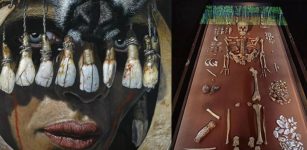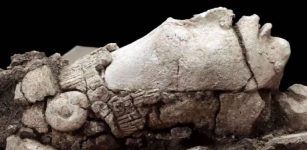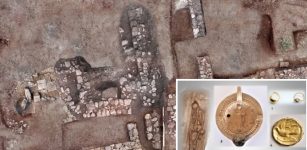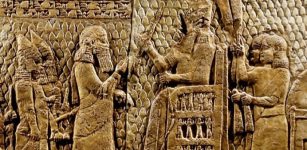Cyclops – First Generation Of Giants Who Were Prisoners Of Tartarus
A. Sutherland - AncientPages.com - The Cyclops are probably best known for their massive, cyclopean masonry and blacksmithing.
Who were these mythical giants?
A first century CE head of a Cyclops, part of the sculptures adorning the Roman Colosseum. Image credit; Steven Lek - CC BY-SA 4.0
This first race of Cyclops – Brontes (thunderer), Sterops (lightener), and Arges (thunderbolt) - were the first generation of Greek giants. They were monstrous children of Gaia, Mother Earth, and Uranus (Ouranos) means 'sky.'
Each of them, as well as their future descendants, such as Polyphemus, we know from the Odyssey, had only a single blazing eye located directly in the middle of the forehead. This eye is said to represent 'the fiery sun.' Each one lived alone with his family on a mountaintop. Their father, Uranus, considered them so shockingly hideous that he threw the Cyclops into Tartarus, the lower region of the Underworld.
Was it only their ugly appearance, which forced the mighty Uranus to get rid of them, or was he simply afraid of their enormous power?
In any case, Uranus believed that he would never see them again. Freed and again placed in the dungeons of Tartarus, the Cyclops had to stay imprisoned for a very long time.
Mother Gaia and her children knew they must cooperate to fight their father. It was apparent that Uranus hated his offspring and hid them in Gaea's body.
She appealed to the sons for vengeance; Cronus (a Titan) alone responded. He took a sickle and removed his cruel father Uranus' testicles as he approached Gaia. As Uranus lay dying, he cursed his son, saying:
"Cronus, it will come to pass that one of your children will do to you what you have just done to me." Then, with a final shudder, a look of anger and betrayal in his eyes, Uranus died
Cyclops: Image credit: Odilon Redon (1840–1916) - collection: Kröller-Müller Museum - Public Domain
Source: https://artsandculture.google.com/asset/the-cyclops-odilon-redon-1840-1916/mAFMK3NTXaN_RQ?hl=en
A sky and weather god, Zeus, raced to Tartarus to release the imprisoned giants. The Cyclops were free because they worked for Zeus, forging thunderbolts.
Cannibals, Craftsmen And Accomplished Builders
Although they were frightening to look at, these young gods were powerful and brilliant craftsmen and accomplished builders. However, different authors described them in their way.
As we know, most mythologies always present several alternative versions of their stories and figures. In Homer's performance, the Cyclops were lawless cannibals dealing with a pastoral life; later authors made them rude, strong, and stubborn giants, but also the craftsmen of Hephaestus and skilled builders.
The famous Cyclopean walls are supposed to be their incredible legacy. Greeks of the Classical Age believed that only the Cyclops, mythical giants, could have been skilled and strong enough to build such gigantic walls. Other structures, such as the massive fortifications of Argos, Tiryns, and Mycenae, were also attributed to the Cyclops.
Pausanius, (c. AD 110 – c. 180, who lived and worked during the reigns of Roman emperors Hadrian, Pius, and Marcus Aurelius, wrote that:
"Nothing is left of the ruins [of Tiryns] except the wall, built by Cyclops with natural rocks, all so huge that a pair of mules would not even begin to shift the smallest. In ancient times, little stones were fitted to bind the rocks together."
As accomplished blacksmiths, the Cyclops contributed remarkable magical weapons for the gods. At first, they created a formidable thunderbolt for Zeus, the most powerful god of the Olympian pantheon.
With this weapon in the form of a handgun launching a death ray, Zeus was able to win the war against the Titans.
Among the Cyclops' other achievements in weaponry were: Hade's Helmet of Darkness, which made its wearer invisible; Poseidon's Trident, which would later become the emblem for the future god of the sea; and Artemis' magical bow and arrows.
Written by – A. Sutherland AncientPages.com Staff Writer
Updated on May 25, 2023
Copyright © AncientPages.com All rights reserved. This material may not be published, broadcast, rewritten or redistributed in whole or part without the express written permission of AncientPages.com
More From Ancient Pages
-
 DNA Study Sheds New Light On The Mysterious 9,000-Year-Old Shaman Burial In Bad Dürrenberg
Archaeology | Nov 29, 2023
DNA Study Sheds New Light On The Mysterious 9,000-Year-Old Shaman Burial In Bad Dürrenberg
Archaeology | Nov 29, 2023 -
 1,000-Year-Old Bone Skate Found In Moravian City Of Přerov, Czech Republic
Archaeology | Mar 20, 2024
1,000-Year-Old Bone Skate Found In Moravian City Of Přerov, Czech Republic
Archaeology | Mar 20, 2024 -
 Unique Seal Stamp That Belonged To Elisabeth Buggesdatter, One Of The Most Powerful Women In Denmark – Discovered
Archaeology | Dec 19, 2018
Unique Seal Stamp That Belonged To Elisabeth Buggesdatter, One Of The Most Powerful Women In Denmark – Discovered
Archaeology | Dec 19, 2018 -
 Countess Loretta Of Sponheim Kidnapped Archbishop Of Trier And Got Away With It
Featured Stories | Sep 26, 2018
Countess Loretta Of Sponheim Kidnapped Archbishop Of Trier And Got Away With It
Featured Stories | Sep 26, 2018 -
 First Detailed Academic Study Of East African Maritime Traditions Shows Changes In Boatbuilding
Archaeology | May 11, 2022
First Detailed Academic Study Of East African Maritime Traditions Shows Changes In Boatbuilding
Archaeology | May 11, 2022 -
 Joseph Pujol – The Professional Farter Who Entertained People
Featured Stories | Jan 29, 2020
Joseph Pujol – The Professional Farter Who Entertained People
Featured Stories | Jan 29, 2020 -
 The Incas Used Stringy Objects Called ‘Quipus’ To Record Data – We Just Got A Step Closer To Understanding Them
Featured Stories | Nov 26, 2024
The Incas Used Stringy Objects Called ‘Quipus’ To Record Data – We Just Got A Step Closer To Understanding Them
Featured Stories | Nov 26, 2024 -
 Mystery How Humans Lost Their Body Hair Solved By Scientists
Archaeology | Jan 4, 2023
Mystery How Humans Lost Their Body Hair Solved By Scientists
Archaeology | Jan 4, 2023 -
 Jigai – Suicide Ritual For Wives Of Samurai – Feminine Counterpart Of Seppuku
Ancient History Facts | Feb 24, 2018
Jigai – Suicide Ritual For Wives Of Samurai – Feminine Counterpart Of Seppuku
Ancient History Facts | Feb 24, 2018 -
 1,300-Year-Old Mayan Maize God Sculpture Found in Palenque, Mexico
Archaeology | Jun 2, 2022
1,300-Year-Old Mayan Maize God Sculpture Found in Palenque, Mexico
Archaeology | Jun 2, 2022 -
 On This Day In History: Great Fire Of London Ends – On Sep 5/6, 1666
News | Sep 5, 2016
On This Day In History: Great Fire Of London Ends – On Sep 5/6, 1666
News | Sep 5, 2016 -
 4,000-Year-Old Village Mentioned In Ancient Texts Unearthed Near Sacred City Of Varanasi
Archaeology | Mar 13, 2020
4,000-Year-Old Village Mentioned In Ancient Texts Unearthed Near Sacred City Of Varanasi
Archaeology | Mar 13, 2020 -
 Ancient Flying Canoes And Magic In The Pacific – Arrival Of Strange People – Part 1
Ancient Mysteries | Jan 28, 2020
Ancient Flying Canoes And Magic In The Pacific – Arrival Of Strange People – Part 1
Ancient Mysteries | Jan 28, 2020 -
 Ruins Of Long-Lost Ancient City Of Tenea Built By Trojans Discovered
Archaeology | Nov 21, 2018
Ruins Of Long-Lost Ancient City Of Tenea Built By Trojans Discovered
Archaeology | Nov 21, 2018 -
 How Did Vikings Celebrate Yule – The Winter Solstice?
Christmas Traditions | Dec 21, 2024
How Did Vikings Celebrate Yule – The Winter Solstice?
Christmas Traditions | Dec 21, 2024 -
 Elizabeth Woodville: Mother Of The Princes In The Tower And Commoner Queen
Featured Stories | Jul 16, 2018
Elizabeth Woodville: Mother Of The Princes In The Tower And Commoner Queen
Featured Stories | Jul 16, 2018 -
 Medieval Mythbusting – New Research Rewrites History Of Glastonbury Abbey
Archaeology | Nov 23, 2015
Medieval Mythbusting – New Research Rewrites History Of Glastonbury Abbey
Archaeology | Nov 23, 2015 -
 Lost Kingdom Of Idu And Its Seven Unknown Kings
Civilizations | Jul 25, 2023
Lost Kingdom Of Idu And Its Seven Unknown Kings
Civilizations | Jul 25, 2023 -
 Justinianic Plague Struck England Before It Reached Constantinople And It Did Not Wipe Out The Roman Empire
Archaeology | Nov 19, 2021
Justinianic Plague Struck England Before It Reached Constantinople And It Did Not Wipe Out The Roman Empire
Archaeology | Nov 19, 2021 -
 Dice Existed Long Before Recorded History And Were Not Always Perfect Cubes
Archaeology | Feb 1, 2018
Dice Existed Long Before Recorded History And Were Not Always Perfect Cubes
Archaeology | Feb 1, 2018


